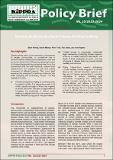Nairobi City County Climate Action Plan 2020-2050
| dc.date.accessioned | 2023-04-07T12:14:54Z | |
| dc.date.available | 2023-04-07T12:14:54Z | |
| dc.date.issued | 2020 | |
| dc.identifier.uri | https://repository.kippra.or.ke/handle/123456789/4133 | |
| dc.description.abstract | Nairobi city is the capital and largest city in Kenya and among the fastest-growing cities in East and Central Africa. It has complex temporal and spatial distributions of population, infrastructure, and socioeconomic activities. Rapid urbanization and unplanned settlement driven by rapid population growth and urban poverty lead the city to an urgency to act to mitigate and adapt to climate change. Nairobi’s most recent Greenhouse Gas Inventory is based on 2016 data and was developed in accordance with global best practice (GPC compliant). Results from the inventory showed that in 2016, total GHG emissions in the city of Nairobi amounted to 4.7 MtCO2e which is equivalent to 1.2 tCO2e per person. The transport sector had the largest contribution. A comparison of national and city-level total GHG emissions shows that Nairobi currently accounts for approximately 5% of Kenya’s total emissions. However, as the largest city in Kenya, Nairobi will likely contribute increasingly to national emissions. major barriers to be removed, i.e. there is a risk it may not be achievable), Nairobi was able to determine the ideal set of actions required to become carbon neutral by 2050. The climate scenarios were compared with the emissions reduction that needs to be achieved to show adequate progress towards achieving an emissions reduction pathway in alignment with the Paris Agreement, which aims to keep global warming below 1.5°C. In the ambitious scenario, the GHG reduction targets are only achieved in 2025 and 2035. In 2050, climate actions implemented achieve a 66% reductions in emissions from the business-asusual scenario, with emissions of around 6 million tonnes still remaining. In order to meet the carbon neutrality goal, much more ambitious actions would be required, including more stringent enforcement of current regulations. An Extended Scenario was developed, considering more aggressive actions but substantive barriers will need to be addressed by Nairobi City County Government in order to move from the Ambitious trajectory to the Extended one. | en |
| dc.language.iso | en | en |
| dc.publisher | County Government of Nairobi | en |
| dc.relation.ispartofseries | Action Plan;2020-2050 | |
| dc.subject | Climate Change | en |
| dc.subject | Climate Action | en |
| dc.subject | Food Systems | en |
| dc.subject | Polution | en |
| dc.subject | Waste Management | en |
| dc.title | Nairobi City County Climate Action Plan 2020-2050 | en |
| dc.type | Development Plan | en |
| ppr.contributor.author | County Government of Nairobi | en |
Files in this item
This item appears in the following Collection(s)
-
Investment Plans [2]



